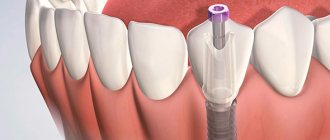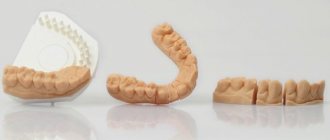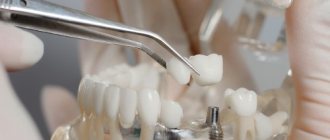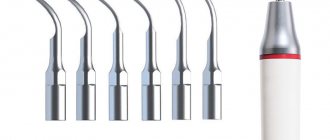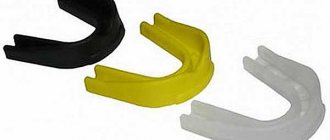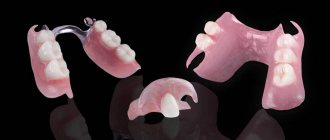The absence of even one tooth is a serious problem, and not only from an aesthetic point of view. After all, it is likely that the chewing load will be distributed unevenly across the remaining teeth, and as a result, the entire dentition will be deformed. In addition, the jaw bone tissues also undergo pathological changes, carious processes are activated, and eventually the remaining teeth may be destroyed. Timely implantation helps to avoid all these troubles.
Why is implantation needed?
The most advanced procedure for restoring teeth today is perhaps implantation.
It is low-traumatic, safe, and allows you to solve the problem in a very short time. The essence of the operation is that a special metal, most often titanium, pin is installed in the patient’s jaw, which will serve as the root of an artificial tooth. Then an abutment is placed on this pin - an intermediate part on which the crown is attached. It is quite possible to install implants immediately after tooth extraction or loss. Its main advantage, compared to conventional prosthetics, is that when installing implants, it is not necessary to grind down adjacent teeth and perform pulp removal. Implantation restores the function of the teeth and jaw and eliminates the risk of bone tissue degeneration.
Possibilities of dental prosthetics using implants Dental prosthetics using an implant will help restore the aesthetics of the smile, as well as the functionality of the jaw. More details THERE ARE CONTRAINDICATIONS. YOU MUST CONSULT A SPECIALIST
In addition, implants help distribute the load evenly across all areas of the jaw, preventing deformation and complications such as pain, malocclusion, and changes in facial proportions.
New Year's discounts! From November 15 to December 31, 2022, reduction in prices for dental prosthetics using implants. View prices THERE ARE CONTRAINDICATIONS. YOU MUST CONSULT A SPECIALIST
Unlike a removable denture, the implant does not need to be removed periodically for cleaning. The owner needs only regular teeth cleaning.
As for the aesthetic side of the issue, crowns cannot be distinguished from your own teeth, since when creating them, specialists take into account the shape, shade and structural features of the patient’s teeth. And, what is especially important for young patients, the implants do not fall out of the mouth when talking or sneezing, since the artificial root is securely implanted into the jaw bone tissue. When chewing and talking, the implants are practically not felt.
Free consultation You can get expert advice, determine a treatment plan and find out the cost at a free initial consultation with a specialist. Sign up THERE ARE CONTRAINDICATIONS. YOU MUST CONSULT A SPECIALIST
Indications for implantation
Indications for implantation, in addition to the absence of one or more teeth, are complete edentia, tooth mobility, periodontal disease, terminal defects of the jaw, increased wear of teeth, open bite.
Contraindications to implantation
However, with all the advantages, implantation also has some absolute contraindications, in which the procedure becomes impossible:
- blood diseases;
- pregnancy;
- severe mental disorders that make communication between doctor and patient problematic;
- individual intolerance to some painkillers;
- malignant tumors;
- connective tissue pathologies.
If previously the list of contraindications to implantation also included diabetes mellitus, hepatitis, periodontal disease and HIV, then thanks to the latest techniques, today there are practically no restrictions for patients with such diseases.
Contraindications Modern implantation has a small list of contraindications and can be performed even with diseases such as periodontal disease, diabetes, HIV, etc. Find out more THERE ARE CONTRAINDICATIONS. YOU MUST CONSULT A SPECIALIST
Main stages of dental restoration
Despite the fact that there are several ways to install implants, the main steps of these methods remain common.
Preparation for implantation
The doctor must make sure that implantation is advisable, that the implant will take root safely, and that the patient has no contraindications to the procedure. First of all, an examination of the oral cavity is carried out and its sanitation is mandatory. Then the patient undergoes tests, the list of which includes a coagulogram showing blood clotting ability, a test for glucose levels, blood biochemistry, tests for HIV, hepatitis and syphilis, and a general urine test. X-rays of the jaw, computed tomography and orthopantogram are performed to determine the quality of the bone and the presence of possible pathologies.
Implant installation
If necessary, bone tissue is built up before this stage, since implantation itself is only possible if there is a sufficient volume of it. Augmentation can be performed in a variety of ways, including bone block grafting, guided regeneration, and sinus lift. After preparing the oral cavity, the immediate installation of the implant is carried out, which lasts a relatively short time.
Installation of abutment and healing abutment in case of classical implantation
To achieve a natural contour of the gum tissue around the future tooth, the doctor installs a gum former three to six months after implantation (only with the classic two-stage implantation protocol). After about two weeks, an abutment is attached to the implant.
Crown installation
With one-stage implantation, this procedure is performed within three to four days after implantation. Crowns are always made based on impressions of the patient's jaw so that the new teeth can fully perform the functions of natural ones. Crowns are placed on the abutment using a special adhesive material.
Rehabilitation
During this stage, the patient must periodically visit the doctor to monitor the condition of the implant, as well as carefully care for the oral cavity.
The duration of rehabilitation depends on the method of implantation and the characteristics of the patient’s body. The final chord of the entire procedure is x-rays, on which, if the operation is successful, the doctor will see the complete engraftment of the implant.
Dental restoration Dental prosthetics using an implant can be used to restore one or more teeth. Learn more THERE ARE CONTRAINDICATIONS. YOU MUST CONSULT A SPECIALIST
Types of implants
Implants include single-phase and two-phase products.
- In the first case, the procedure for installing a dental implant lasts about an hour and the aesthetic effect is achieved immediately, since the single-phase implant is suitable for immediate loading and is covered with a temporary prosthesis. This option is especially recommended for the front teeth.
- Biphasic implants are installed in two stages. First, install the implant itself, which replaces the root of the missing tooth. A crown is placed on a tooth only after the wound has healed (after several months).
What is included in turnkey dental implantation?
Some dental clinics offer turnkey implantation. Is this really beneficial and convenient for the patient and what exactly is included in this service?
Let’s imagine a situation: a client came to the clinic for a consultation and received information about the cost of the service. He was completely satisfied with this cost, and he decided to undergo implantation. However, during the course of treatment, he learns that the figures announced are only the price of the implant itself, and it does not include additional manipulations, which, it turns out, are impossible to do without. The client ends up having to pay an amount that is not at all what he was prepared to pay after the initial consultation.
In the case of turnkey implantation, the patient initially receives information about the cost of each service and can make a conclusion about the availability of treatment based on objective figures, since the total amount will not change during the operation.
The cost of turnkey implantation usually includes the following:
- initial consultation with an orthopedist and implantologist;
- comprehensive examination;
- selection of an implantation system and its installation;
- control during the rehabilitation period with x-rays;
- installation of a temporary orthopedic structure if an immediate loading protocol is selected;
- visits to the clinic within a year after the procedure to monitor the condition of the implant.
The total cost also includes anesthesia, the work of the doctor and nurses, and a guarantee of the quality of the implant.
How much does dental implantation cost? The cost of dental services may be influenced by the chosen method of tooth restoration and materials. Find out the cost THERE ARE CONTRAINDICATIONS. YOU MUST CONSULT A SPECIALIST
Veneers
Dental clinic "Denta-Prestige" presents to your attention one of the most popular types of prosthetics - veneering. It consists of lining the outer side of the front row teeth with a thin layer of ceramics. With the help of veneers, it is possible to hide defects such as chips, changes in shade, and unevenness. As a result of the procedure under consideration, the tooth acquires an aesthetic appearance and gains protection from various influencing factors.
Restoring teeth using crowns
Various dental damage can be restored using crowns. High-quality prosthetics are provided by devices made of ceramic and metal-ceramic materials. The installation of crowns is carried out according to the standard procedure: the soft tissues of the tooth are removed and filled with a special material. Next, the wall is ground to a thickness equal to the size of the crown. A fake tooth is made from an impression in the laboratory, and then tried on and fixed with permanent cement.
Treatment protocols
Initially, there was only one implantation protocol - a two-stage one, requiring a long time for implant installation. However, in recent years, more modern protocols have been developed that allow the patient to get new teeth very quickly.
One-shot protocol
Implantation according to this protocol is the installation of a titanium monoblock implant using a compression method through a small hole in the jawbone. This eliminates major surgical intervention, which means healing is accelerated. Usually performed after the removal of a problematic tooth.
This protocol is used even if the patient is missing more than three teeth, and even with complete edentia. The only limitation is that the patient must have a sufficient amount of bone tissue, since if there is a lack of it, a gentle method cannot be applied.
The main difference between the one-stage protocol is that immediately after the implant is implanted, the patient is given a temporary crown, so that the person will not suffer from a missing tooth for several months, as with a two-stage protocol. After complete implantation of the implant, a permanent crown or prosthesis is attached to it, the material of which is chosen by the patient in advance.
The treatment period takes three to four days, and complete healing takes up to approximately two weeks. The main advantage of the protocol is low trauma, since there is no need for repeated surgery to fix the abutment and install the prosthesis. In addition, the patient returns to an active lifestyle faster, which is especially important for young people.
Basal implantation
If the patient’s bone tissue is significantly atrophied and conventional one-stage implantation is impossible, one-stage basal implantation is performed.
With this method, the titanium implant is installed not in the area of the alveolar process, as with the two-phase protocol, but in the deeper basal layers of the bone. That is why the method is applicable for patients with significant bone tissue deficiency without the need for bone augmentation procedures. Basal implantation is minimally invasive, since a full surgical tissue incision is not made, and the implant is inserted through a small-diameter puncture.
With this method, it is possible to install implants “at an angle” in those places where bone tissue density is higher, which gives greater fixation strength. Since monoblock implants are also used in basal implantation, they are immediately loaded with crowns, so that the patient does not experience aesthetic inconvenience due to the absence of a tooth, and can also chew fully.
Basal implantation has proven itself especially well in cases where a person is missing several teeth in one row, there is complete edentia, or a lot of time has passed since the loss of teeth. If it is necessary to insert one tooth, the doctor may recommend other protocols, since the proximity of “living” teeth to the implant may interfere with implantation “at an angle.”
The treatment period for basal implantation is also short - from three to four days. Complete healing occurs in approximately two weeks.
Based on one-step protocols, modern fixed dentures are manufactured using the All-on-4 system, when the entire structure of the prosthesis is attached to four implants implanted in the jaw.
Two-step protocol
This is a classic of implantation; this is where all modern implantology began. The difference between this protocol and the one-step protocol is that it is carried out in two steps, separated by a significant time interval.
Two-phase implantation is indicated in almost all cases of missing teeth - from one to the entire row of teeth. It is distinguished by its reliability and predictability of the final result. In addition, by suturing the wound after implantation, the likelihood of infection getting into it is eliminated.
The procedure is as follows. At the first stage, an implant is implanted into the patient’s jaw through an incision, after which the patient, while waiting for the implant to fully engraft, lives for quite a long time practically without a tooth.
At the second stage, the gum at the installation site is again opened to fix the abutment, and the necessary procedures are performed to form the gum contour. After some time, the crown is attached to the abutment.
On a note
The two-stage protocol is carried out only if there is a sufficient amount of bone tissue! If there is a deficiency, osteoplasty or sinus lifting is performed before implantation to build it up.
The main disadvantage of the two-phase protocol is that it takes too long. Depending on the condition of the bone tissue and on which jaw the manipulation was performed on, the total duration of the protocol can be about a year. In addition, this method is the most invasive: the gums are cut and sutured.
Turnkey implantation: price issue
How much will a turnkey implantation cost? This depends, first of all, on the implantation protocol, on the manufacturer of the prostheses, and on the materials used to make the crowns (see Table 1).
Table 1. Average prices for dental implantation
Service
price, rub.
Installation of one classic implant on a turnkey basis
From 25 000
Installation of one one-stage turnkey implant
From 35 000
One-stage implantation of one jaw (6–10 implants) “turnkey”
From 265,000
One-stage implantation of two jaws (14–20 implants) “turnkey”
From 480,000
Simultaneous implantation of one tooth (with extraction)
From 44 000
Prosthesis (removable) All-on-4 for one jaw “turnkey”
From 173,000
Prosthesis (fixed) All-on-4 for one jaw “turnkey”
From 300,000[1]
Which clinic to choose? When choosing a dental clinic, you should pay attention to the availability of licenses, the qualifications of the staff, as well as the technical equipment and reputation of the organization. Where can I go? THERE ARE CONTRAINDICATIONS. YOU MUST CONSULT A SPECIALIST
In any case, before choosing an implantation method, you should consult a doctor: only a specialist can choose the most suitable method, taking into account the condition of the bone tissue, the number of implants needed and other characteristics of the body. Implantation is still quite an expensive pleasure, and in order for the result to be ideal, it is very important to choose the right clinic.
Fixed prosthetics
The advantages of fixed dental prosthetics are high aesthetics and natural use of orthopedic structures. Their installation does not cause any discomfort, and they do not create a sensation of the presence of foreign objects in the human oral cavity. Caring for dentures of this type is absolutely no different from dental hygiene given by nature.
There are few types of fixed dental structures. When choosing a particular one, the dentist relies on the state of the dental system as a whole. For example, if the bone formation of the oral cavity is not completely damaged, then experts in this case recommend installing a crown, which can subsequently prevent tooth destruction.
